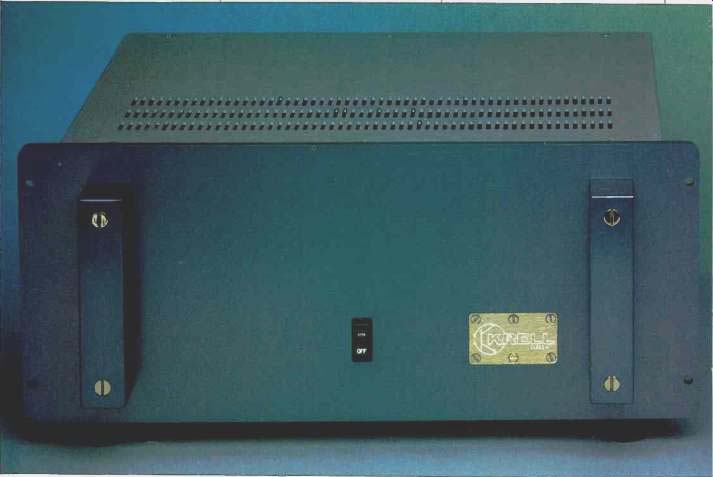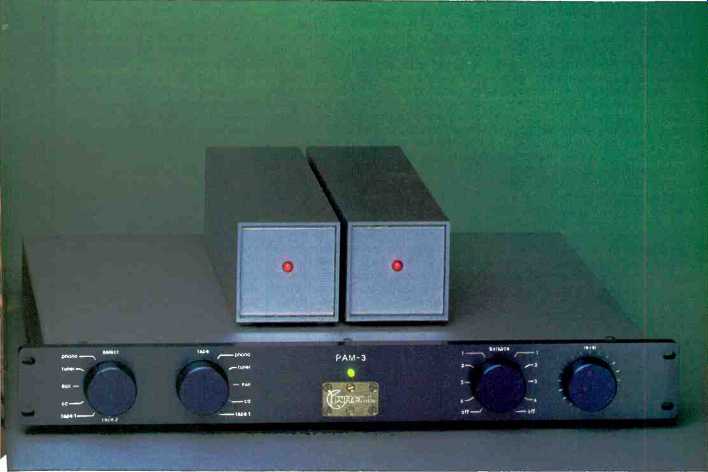

Company Address: 20 Higgins Dr., Milford, Conn. 06460, USA.
If you want to hear just how good transistor equipment can get, you really need to listen to the Krell PAM-3 preamplifier and KSA-50 power amplifier. In fact, if you want to know how good any audio equipment can get, you owe yourself a listening session with this gear. I don't mean by this that Krell lacks competition for the top of the heap; I know from personal experience that the latest Klyne, Threshold, Audio Research, and conrad-johnson gear is equally worth a trip to one of the few high-end dealers who can properly demonstrate it. Nevertheless, these two Krell units are a unique sonic statement by a top designer and make the high prices of the high end worthwhile.
Krell PAM-3
The PAM-3 preamplifier sells for $2,850, and is a pure Class-A, dual-mono design. It is a basic preamp only in that it has no tone controls. It uses two separate external power supplies, has an extraordinarily flexible set of inputs that can accommodate even the most complex system, has the gain for low-output moving coils, provides a very wide range of internal adjustments to load cartridges with various impedances, and has an adjustable phase filter to improve the sound of CD players. The construction is beautiful, both internally and externally, with a unique mix of gray finish and brass screws and logo panel.
The sound is not perfect, but it is so neutral and detailed that I find it difficult to say much about the sound character of the PAM-3. There is no trace of upper-midrange hardness, tizziness or hardness in the highs, or alteration in timbre. The Krell passes unchanged virtually every nuance and detail in the input signal; its only "fault" is that it lets so much detail through that it demands superb source material. Good or bad, you get the music you put in, with remarkably little alteration.
In fact, the only way I can put the overall sound character of the Krell PAM-3 in any perspective, without drowning you in superlatives, is to compare it to the SP-10 II from Audio Research. The PAM-3 and SP-10 II illustrate the difference between top transistor and tube designs. The solid-state Krell is more extended in the highs and benefits from its superior signal-to noise ratio. It can be used with virtually any low-output moving-coil cartridge, while the SP-10 II prefers a minimum of 0.2 to 0.5 mV. The dead silence of the Krell is apparent, however, even on high-level inputs and particularly in very low passages. You can listen down into the noise floor of analog source material better on the Krell than on the Audio Research SP-10 II or on any other unit I have yet heard.
Both preamps have excellent bass and upper octaves, but listening solely to a subwoofer shows that the Krell PAM-3 is slightly superior in the deepest bass. The SP-10 II has a slightly more open sound stage, is a little bit warmer in the midrange, is somewhat more "holographic" in its imaging, and handles transient detail in a way that gives it a more forward or front-of-the-hall character. The Krell PAM-3 has rock-solid imaging and sound-stage stability that I have never heard equaled, a mid-hall sound, and an al most uncanny purity. Both the Krell and Audio Research preamplifiers are superb vintages, but they come from different vineyards.
The Krell's phono stage is also worth special mention. It allows a wide range of different impedance and capacitance settings, using easily adjustable, internal DIP switches. Coupled to the Krell's purity, it virtually demands long listening sessions to choose the exact adjustment suited to your system. The PAM-3 also has the kind of purity that makes you all too well aware of a moving coil's rising high end or a moving magnet's tendency to blur transient detail. The Krell PAM-3 can get the best from any cartridge, but it definitely demands the best cartridge.
The Krell's special CD input produces some fascinating improvements in CD sound. This is not just a renamed AUX input; it includes a high-voltage buffer and a phase filter which can be adjusted to match various players, or defeated altogether. This input configuration cannot soothe the savage CD player, but it does add a marvelous coherence to a good one and eases the upper-octave pain of a mediocre one. The upper octaves in a good CD player like the Meridian come into much better focus with the midrange, rather than leading the midrange with a slightly irritating edge. The sound stage widens, and depth is significantly improved. Once again, you will probably want to experiment with the various adjustments you can make by using the internal DIP switches. Don't expect dramatic differences, but do expect to end up with a much more natural sound stage and less listening fatigue in the highs.
You also, incidentally, should pay careful attention to the placement of your speakers and the interaction be tween this placement, cartridge loading, and the combination of vertical tracking angle (VTA) and stylus rake angle (SRA). The Krell PAM-3 will sound a bit "closed in" if you place the speakers as close together as is desirable with most other equipment. I suspect this is partly due to its exceptional silencing and image stability. In any case, widen the spacing between your speakers to open up the image. You will find that the Krell has exceptional center fill, and that it provides a sound stage that combines both openness and stability.
Similarly, the Krell is exceptionally revealing of the imaging and soundstage impact of VTA/SRA and cartridge loading. You can take advantage of this to adjust VTA/SRA and natural sound stage possible from your listening room and speakers. Lowering the tonearm base tends to move your listening position slightly back in the hall, while raising the tonearm base, so the cartridge tilts slightly up in the rear, will move the sound stage forward. Higher loading impedances on moving coils open up the sound stage, while lower impedances improve center fill.
I should probably stress that moving the speaker is the superior means of adjusting the sound stage. Ideally, VTA/SRA and cartridge loading should be set for maximum upper-octave de tail at the point where upper-octave timbre is most natural. Nevertheless, these adjustments are an important alternative to getting just the right sound stage in the many rooms where there simply aren't that many options for speaker location.
As for other details of the PAM-3, the only thing missing, other than tone controls and filters, is a second phono input. The control functions have the smooth touch of luxury; the quality of the RCA jacks is superb; etc., etc. In short, this is one of those vintage high-end products that convinces you that the high end is not simply hype and money. It also has the kind of sonic merit you really need to hear for your self-even if you can't afford one to morrow. The PAM-3 is one of those few reference-quality units around which you can build the rest of your system with absolute confidence.
Krell KSA-50
The Krell KSA-50, which sells for $2,300, is an excellent match for the PAM-3. It has the same superb workmanship and styling, and is definitely a luxury-class power amplifier. At the same time, it is a true Class-A design, rather than one of the host of quasi-Class-A circuits. Its nominal 50 watts per channel turn into 100 watts at 4 ohms, 200 watts at 2 ohms, and enough power at 1 ohm to drive a pair of Apogees. No matter how hard you drive it, the KSA-50 will get warm but not hot.
This Krell amp rivals the Audio Research D-250 Mk II and conrad-johnson Premier 5 in terms of its ability to resolve detail from the music. It is similar to the PAM-3 in that its sound-stage perspective is one-third back to mid-hall, as well as extraordinarily stable and well controlled. By comparison, the Audio Research and conrad-johnson have a slightly more open sound and give the impression of slightly faster handling of transients-although any technical measurement probably would disagree. The Krell has a more liquid sound that suits its hall perspective, but has the "air," or fine musical detail, that is normally found only in tube equipment.
The Krell is also the first pure Class-A power amplifier I have heard that delivers the full promise of Class A.
Normally, there is always something wrong in the integration of the highs, and the purity at low levels does not hold up as the volume increases. The Krell has a rare quality in any power amplifier: It sounds consistently natural and integrated in all its sonic characteristics.
The KSA-50 is also one of the few transistor power amplifiers that lets you listen to the faintest musical information on lowest level sounds without having the feeling that the room has suddenly grown smaller or a veil pulled across the music. This seems to be part of signal-to-noise ratio, which makes the Krell a remarkably unobtrusive and neutral design. It outperforms any tube or other transistor power amplifier I have heard in this regard. This means the Krell is exceptionally pleas ant to listen to at low volume levels or with softly played solo instruments.
Speaking selfishly, the Krell KSA-50 joins the Futterman OTL-3 and the Audio Research D-250 II as one of the three basic amplifiers I have auditioned that allowed my Quad ESL-63s to reproduce what really sounded like live music in my home. I should note, however, that I used different records in each case, and that the Krell KSA-50 benefits from a slightly warm moving coil such as the Kiseki Purple Heart or one of the new Koetsus. Within its power range, the Krell KSA-50 is by far the best basic power amplifier in the deep bass I have heard in the last year.
I have been playing around with subwoofers recently, and it is amazing how few transistor amplifiers can really drive them properly (no tube amplifier can). Most transistor amplifiers that do manage to perform well have at least 100 watts per channel. With a good low-impedance speaker cable, the Krell locks in a good subwoofer and offers an extraordinary combination of power and control.
The Michelin Guides rate best restaurants as "worth a detour." The Krells definitely qualify as that kind of audio cuisine. In an ideal world I would ask the chef for more power (he has 100- and 200-watt designs on other burners), and a slightly more open sound. I would also ask that this sound be seasoned with the transient speed of tubes while retaining all the unique virtues listed above. I have this sudden taste for a transformerless Class-A tube amplifier with at least 40 tubes and with the tube filaments replaced by transistors. . . .
More seriously, however, this is the kind of equipment that is worth a serious appointment with a high-end dealer, to whom you can bring your own records, tapes, or CDs and listen long enough to see just how much really good electronics can do for music.
Once you have sampled Krell and the best competing brands, you may find you have vastly improved your taste for music. Be careful, however; few converts to gourmet living can ever go back to a steady diet of junk food!
-Anthony H. Cordesman
(Source: Audio magazine, Dec. 1985)
Also see: Krell MD-1 CD Transport and SBP-64X Digital Signal Processor (June 1991)
Lazarus H-1A Amplifier (Sept. 1990)
= = = =